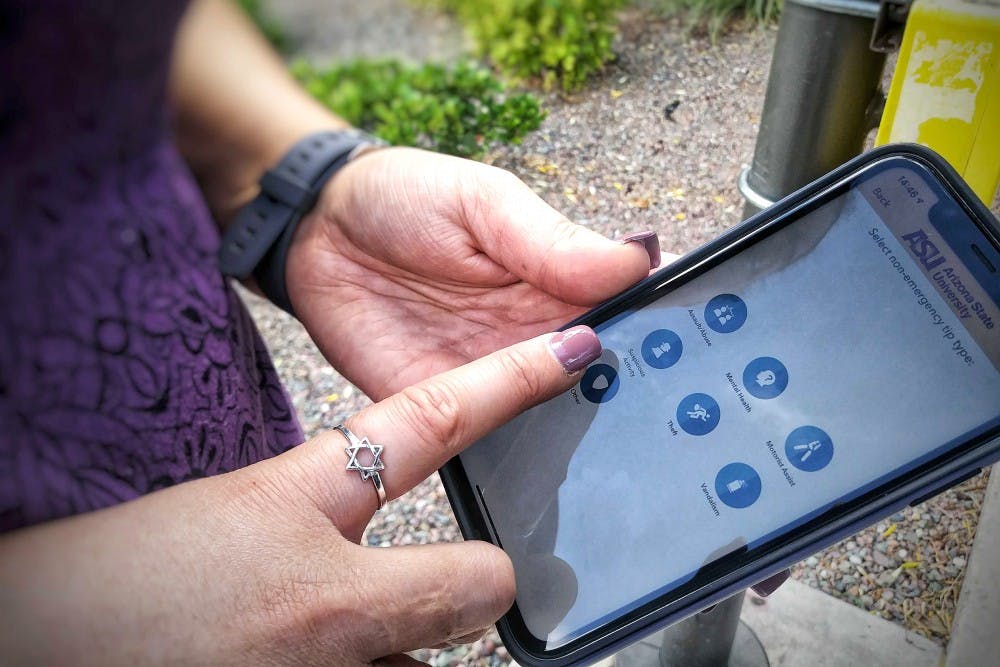ASU is making efforts to improve safety on campus through LiveSafe app improvements, blue-light call boxes and introducing LanguageLine InSight — an app that allows officers to translate over 36 different languages through video call — into the police force.
The LiveSafe app was first introduced to ASU in fall 2014, when ASU Police Chief Michael Thompson wanted to implement a new safety resource for ASU students.
According to Dan Verton, the content leader and strategist of the LiveSafe app, ASU was one of the first campuses to implement the app.
“ASU is one of our biggest and longest partners, and ASU is really a shining example of how to do this correctly,” Verton said.
Verton said that the company is currently working to incorporate artificial intelligence into the LiveSafe app. By doing this, they hope to calculate the likelihood of potential crimes on campus and send officers where they are needed before the incident occurs.
“We’re able to leverage machine learning to actually analyze … where crimes are taking place, when they're taking place and what types of risk and crimes your location is facing, so you can take more proactive steps to prevent those things from happening,” Verton said.
There are some students who feel the app also needs to be updated in order to ensure safety on campus.
Sarah Winkelman, a senior studying political science and global studies, believes that the app is outdated.
“It literally hasn't changed in four years,” Winkelman said.
Winkelman has used LiveSafe since starting college at ASU. She said that she primarily uses it for escorts and reporting incidents.
However, Winkelman believes there are times that the app is slow or simply doesn’t have a good response time. She said this is because there is sometimes an insufficient number of workers on the app.
“It'd be great if they had more people working to get a quicker response or something like that,” Winkelman said.
Among the different features of the LiveSafe app, students have the opportunity to see the location of call boxes on campus. Blue-light call boxes allow students to contact police to receive assistance or dispatch officers if needed.
ASU Police Lieutenant Joseph Morel said that police have been trying to find ways to make the call boxes more convenient, and some of the blue-light call boxes even have added cameras.
Morel also noted that when in danger, instead of waiting at a blue-light call box, he recommends students run to the next light ahead of them, press the button and scream.
He said that by doing this, police will be able to track where students are going and get a general idea of where to meet them without placing the student in danger by waiting at the call box. And by screaming, students show the officer that there is sufficient danger, as there have been incidents of pranks by students in the past.
“Don’t be paranoid but be alert … everybody’s safety is my main concern,” Morel said.
The most recent addition to the safety programs at ASU is LanguageLine InSight. The app was introduced to ASU after Patricia Pryce, communications manager for ASU PD, discovered it and helped bring LanguageLine InSight to campus in 2018.
“The officer has the app on their phone, they give it to the students and then the student talks to it,” Pryce said.
The app allows officers to begin a video call with a translator, who will then relay what students are saying to the officers.
The app currently offers 36 languages to translate through video call, including sign language. Pryce said she hopes this addition will allow students to feel more comfortable talking to police officers.
“The idea was to try to provide more customer service to our students whose second language is English," Pryce said. "This way, we can help them a little more, a little better, just make sure that they have somebody who understands what they're asking."
Statistics also indicate that there can be a reduction in crime if technological advancements prove to be successful. Overall, crime declined in 2017 compared to years prior, according to the University’s 2018 annual crime statistics.
ASU officials like Morel and Pryce hope that the incorporation of the new technology will encourage ASU students to talk to police when they feel unsafe.
“Allow us to build a working relationship with the students," Morel said. "Let's work together and keep each other safe."
Editor's Note: Stacy Brinson is also an opinion columnist for The State Press, but this article is not reflective of her personal views.
Reach the reporter at slbrinso@asu.edu or follow @Stacy_L_Anders on Twitter.
Like The State Press on Facebook and follow @statepress on Twitter.




